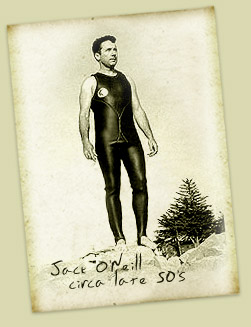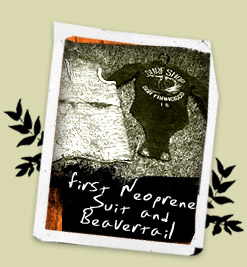| |
- or rather, ignored
-- a version of the "When I was a kid" lecture from
our elders, squirming through some rambling nonsense about walking
to school without shoes or life without video games. Well, if
you were one of Jack O'Neill's children, founder of O'Neill Inc.
and wetsuit inventor, you might very well listen as he told ice-cold
horror stories that drove him to develop our trusty neoprene armor.
Hell, you may end up helping with a few inventions of your own.
In 1952, Jack opened his first surf shop in a garage across the
Great Highway in San Francisco, a sand dune away from his favorite
bodysurfing break. There he sold his first wetsuits, a few vests
he made from gluing together pieces of neoprene. From that very
garage Jack expanded the average surfer's playground from Steamer
Lane to J-Bay, Antarctica and those fun reefbreaks off the coast
of Iceland. Thanks to Jack O'Neill, "It's always summer on
the inside."
"Surfing in the 50s was great," says Jack. "You
knew everybody and we all took turns on the waves." But
surfing in the 1950s also meant short sessions due to the cold
water temperatures, and surfers tried anything to stay warm. "I
remember one guy that tried to keep warm with a navy jumper
and he put Thompson's Water Seal on it," recalls Jack.
 |

"He set out in an oil slick all by himself." Cold
and sick of cutting his sessions short at Ocean Beach,
Jack embarked on a mission to create the wetsuit.
Jack soon became a regular at surplus stores collecting
old WWII frogmen suits. "These suits consisted of a
thin sheet of rubber, worn over something like long underwear,"
says Jack. "The air trapped in the underwear gave the
insulation. But in the rough surf the suit would come apart
at the waist entry, water would get in, displacing the air
and making it hazardous."
|
| |
|
Working with different types of flexible foam, his first success
was with polyvinylchloride (PVC). While it had good insulating
properties, it was prone to a lot of wear and tear so he glued
a sheet of plastic to the PVC and made a vest. Voila! His first
wetsuit. Yet, while PVC served its purpose, it was hard to work
with and Jack went back to the drawing board.
Jack finally struck gold with neoprene, which he discovered carpeting
the aisle of a DC-3 passenger plane.
It was a good insulator, buoyant and easy to bond. Soon after
Jack developed designs for the shorty, long john and long-sleeved
beaver-tailed jacket wetsuits. "I got a lot of laughs," remembers
Jack. "Surfers would come up from down south and I remember
one of them saying, 'Maybe you clowns up here need a suit but
never us.' I was just trying to do more surfing, have some
surfing friends and get a little income." Despite all
the naysayers, the vests started to fly off the hangers and
O'Neill was in business.
Since then, O'Neill has made countless improvements to the
design and quality of the wetsuit, from the introduction of
the zigzag stitch to the most recently patented Zipperless
Entry Neck (Z.E.N.) design. But accomplishments are nothing
new to the O'Neill family. Jack was always a man of firsts,
responsible for creating the modern-day surf shop. While guys
like Dale Velzy and Hobie Alter had shops down south, they
only sold boards.
"Since I was making wetsuits and surfboards, I decided
to call my place Surf Shop. And I was able to get a federal
trademark registration on the name surf shop too," says
Jack. He also pioneered the surfboard travel bag and was one
of the first to start blowing foam blanks.
The inventor's gene seems to run in the family, too. His son
Pat was a pioneer in developing the leash, affectionately known
as the "kook cord" back then. Using materials such
as nylon lines, suction cups and surgical tubing, Pat found
ways to prevent his board from crashing into the cliffs and
breaking in half.
"It was extremely hard to see the surgical tubing, and
when I fell off my board, the board went into the wave and
stretched the tubing out 22- to 23-feet," says Pat. "And
then it came racing back like a speeding bullet. People had
never seen anything like this. They thought it was a remote
control or something."
|
|

